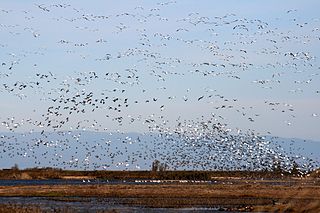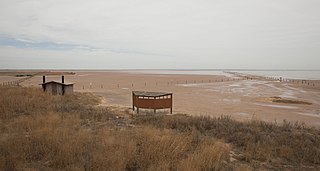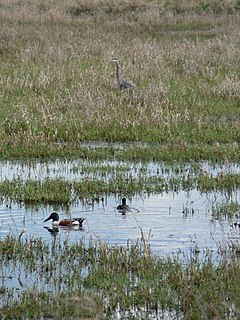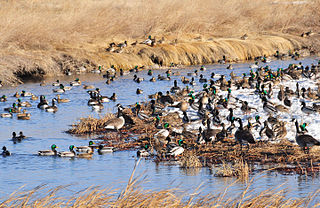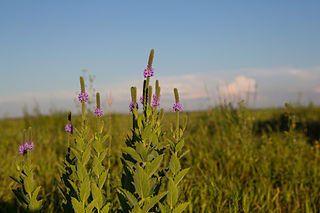| Washita National Wildlife Refuge | |
|---|---|
IUCN category IV (habitat/species management area) | |
 Sunset at Washita NWR. 22 November 2013. Courtesy U.S. Fish & Wildlife Service | |
Map of the United States | |
| Location | Custer County, Oklahoma, United States |
| Nearest city | Butler, Oklahoma<"EOHC-WNWR"> |
| Coordinates | 35°36′30″N99°15′02″W / 35.60838°N 99.25065°W [1] Coordinates: 35°36′30″N99°15′02″W / 35.60838°N 99.25065°W [2] |
| Area | 8,075 acres (32.68 km2) |
| Established | 1961<"EOHC-WNWR"/> |
| Governing body | U.S. Fish and Wildlife Service |
| Website | Washita National Wildlife Refuge |
Washita National Wildlife Refuge is a National Wildlife Refuge (NWR) of the United States located in Custer County, Oklahoma. Created in 1961 on the shore of Foss Lake, it was the fourth NWR in the state. It is 5 miles (8.0 km) west of Butler, Oklahoma. [3]

National Wildlife RefugeSystem is a designation for certain protected areas of the United States managed by the United States Fish and Wildlife Service. The National Wildlife Refuge System is the system of public lands and waters set aside to conserve America's fish, wildlife, and plants. Since President Theodore Roosevelt designated Florida's Pelican Island National Wildlife Refuge as the first wildlife refuge in 1903, the system has grown to over 562 national wildlife refuges and 38 wetland management districts encompassing more than 150,000,000 acres (607,028 km2).

The United States of America (USA), commonly known as the United States or America, is a country comprising 50 states, a federal district, five major self-governing territories, and various possessions. At 3.8 million square miles, the United States is the world's third or fourth largest country by total area and is slightly smaller than the entire continent of Europe's 3.9 million square miles. With a population of over 327 million people, the U.S. is the third most populous country. The capital is Washington, D.C., and the largest city by population is New York City. Forty-eight states and the capital's federal district are contiguous in North America between Canada and Mexico. The State of Alaska is in the northwest corner of North America, bordered by Canada to the east and across the Bering Strait from Russia to the west. The State of Hawaii is an archipelago in the mid-Pacific Ocean. The U.S. territories are scattered about the Pacific Ocean and the Caribbean Sea, stretching across nine official time zones. The extremely diverse geography, climate, and wildlife of the United States make it one of the world's 17 megadiverse countries.

Custer County is a county located in the U.S. state of Oklahoma. As of the 2010 census, the population was 27,469. Its county seat is Arapaho. The county was named in honor of General George Armstrong Custer.
Within the refuge, the slow-moving Washita River winds through prairie and cropland to merge with Foss Reservoir, providing a home and resting area for geese and other waterfowl. Gently rolling hills, ravines, and bottomlands laced with creeks shelter wildlife as common as white-tailed deer and as unusual as the Texas horned lizard, a state-listed endangered species.
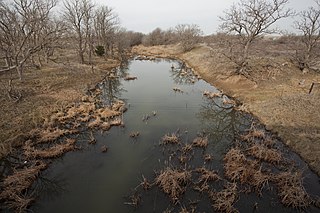
The Washita River is a river in the states of Texas and Oklahoma in the United States. The river is 295 miles (475 km) long and terminates at its confluence with the Red River, which is now part of Lake Texoma on the Texas–Oklahoma border.

Prairies are ecosystems considered part of the temperate grasslands, savannas, and shrublands biome by ecologists, based on similar temperate climates, moderate rainfall, and a composition of grasses, herbs, and shrubs, rather than trees, as the dominant vegetation type. Temperate grassland regions include the Pampas of Argentina, Brazil and Uruguay, and the steppe of Ukraine, Russia and Kazakhstan. Lands typically referred to as "prairie" tend to be in North America. The term encompasses the area referred to as the Interior Lowlands of Canada, the United States, and Mexico, which includes all of the Great Plains as well as the wetter, hillier land to the east.
Foss Reservoir, also known as Foss Lake, is in Custer County, Oklahoma on the Washita River, about 15 miles (24 km) west of Clinton, Oklahoma. The reservoir was constructed during 1958–1961 by the U. S. Bureau of Reclamation. The project was known originally as the Washita Basin Project. The lake and dam were named for the community of Foss, Oklahoma, about 6 miles (9.7 km) south of the site. The primary purposes are to regulate flow of the river and to provide water for the cities of Bessie, Clinton, Cordell and Hobart. It is western Oklahoma's largest lake and lies entirely within Foss State Park.
The United States Fish and Wildlife Service has reported 270 bird species as having been seen in the NWR. These include occasional sightings of the bald eagle and rare sightings of whooping cranes. Outdoor activities allowed in the NWR include birdwatching, boating, hiking, fishing, and limited hunting. Hunting is allowed only in certain seasons and with special permits. Quarry includes deer, geese, sandhill cranes, quail, and rabbits. [3]


